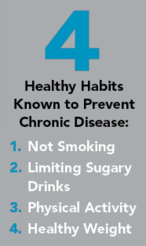October 2017
Having trouble viewing this email? View it as a Web page.
The Importance of 4 Healthy Habits
Few Alaska
Adults Report 4 Healthy Habits Known to Prevent Chronic Disease
Four healthy habits — not smoking, limiting consumption of sugary drinks, being physically active, and maintaining a healthy weight —
are associated with reduced risk for several of Alaska’s leading causes of
death, including cancer, heart disease, stroke, and type 2 diabetes.[1,2] A recent study
from the Alaska Section
of Chronic Disease Prevention and Health Promotion (CDPHP) found that
only 15% of Alaska adults reported all four behaviors. |
|
 |
Healthy
habits among Alaska adults
Using almost 3,000 responses from the 2015 Alaska Behavioral
Risk Factor Surveillance System (BRFSS), CDPHP epidemiologists evaluated the
prevalence of four healthy habits among Alaska adults:
-
Not smoking (current non-smokers, including never smokers and
former smokers)
-
Maintaining a healthy weight (Body Mass Index of 18.5-24.9)[3]
-
Being physically active (meeting the national
guidelines for aerobic physical activity of 150 minutes per week)[4,5]
-
Limiting consumption of sugary drinks (drinking less than one
sugary drink per day)[6]
Only 15% of Alaska adults reported all four healthy habits:
-
37% had three healthy behaviors,
-
32% had two healthy behaviors,
-
14% had one behavior, and
- 2% had none.
The
least common healthy habits were being physically active (59%) and maintaining
a healthy weight (32%). Most Alaska adults reported not smoking (81%) and
limiting consumption of sugary drinks (77%).
CDPHP epidemiologists focused on these four healthy
habits because they are behaviors addressed by the Section’s programs and they
are behaviors that can be changed and improved. This
study found that the number of healthy habits reported by adults varies
by several characteristics, including sex, race, poverty, and the number of
adverse childhood experiences.[7,8] Compared to those reporting all four healthy habits, Alaska adults who reported
none of the four healthy habits were more likely to be male;
Alaska Native; living in poverty; and reporting four or more adverse childhood
experiences.[9]
Promoting healthy
habits in Alaska
CDPHP is working with partners
to make it easier for Alaskans to adopt and maintain healthy habits. Our program partners engage communities in a
variety of ways to expand their understanding of the health harms of tobacco
use and exposure to secondhand smoke, to support protective policies, and rally
youth to avoid using tobacco. Health care system partners ask
and advise patients on healthy choices and refer smokers to tobacco cessation
services, such as Alaska’s Tobacco Quit Line (1-800-784-8669). School districts work to establish
tobacco-free campuses, offer nutritious foods and drinks, and provide quality
health and physical education. The Section also provides free public education
materials and resources focused on tobacco
prevention and cessation, increased daily
physical activity, and reduced
consumption of sugary drinks. The Section’s efforts and partnerships also focus on Alaska Native people; youth; young adults; adults
with lower levels of income or education; adults with mental illness or
substance use disorders; and lesbian, gay, bisexual, and transgender
communities.
Alaskans
can enjoy longer, healthier lives by avoiding the use of tobacco products,
maintaining a healthy weight, being physically active, and drinking fewer
sugary drinks. Additional healthy choices include eating
more fruits, vegetables, whole grains, and lean proteins; choosing
water and low-fat or nonfat milk instead of sugary drinks; and limiting
television and screen time that’s not work- or school-related to no more than two hours each day.
Find more information
CDPHP’s website contains Information on the
2015 Alaska
Behavioral Risk Factor Surveillance System (BRFSS), a telephone
survey of adults. Additional details on datasets for these four healthy habits can be
found at AK-IBIS.
To learn more about CDPDP
efforts in areas related to the four healthy habits listed above, contact Karol Fink, Obesity Prevention and Control Program Manager (karol.fink@alaska.gov), or Cheley Grigsby, Tobacco
Prevention and Control Program Manager (michelle.grigsby@alaska.gov).
To find out more about Adverse Childhood Experiences, known as ACEs, go to the Division of Behavioral Health's program page.

References:
-
State of Alaska, Health
Analytics and Vital Records. 2015 annual report. Accessed
February 15, 2017.
-
Ford ES,
Bergmann MM, Kroger J, et al. Healthy living is the best revenge: findings from
the European Prospective Investigation into Cancer and Nutrition-Potsdam Study.
Arch Intern Med 2009; 169(15):
1355-1362.
-
Body mass index (BMI) is
calculated as: Weight (in kilograms) / Height (in meters) ^2
-
U.S. Department of
Health and Human Services. 2008
physical activity guidelines for Americans. Accessed February 15, 2017.
-
Being physically active was
defined as 150 minutes of moderate-intensity or 75 minutes of
vigorous-intensity aerobic physical activity per week or equivalent.
-
Sugary drinks include regular
soda or pop, fruit drinks with added sugar, sweetened powdered mixes,
vitamin-enhanced water beverages, sweet tea or coffee drinks, and sports or
energy drinks.
-
Poverty guidelines are issued
each year in the Federal Register by the Department of Health and
Human Services (HHS).
-
Adverse childhood experiences
(ACEs) were defined by the CDC-Kaiser Adverse Childhood Experiences (ACE) study.
|